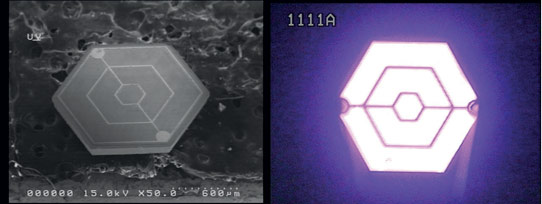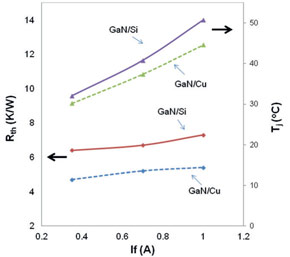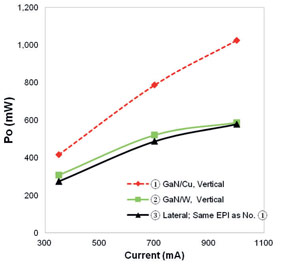Verticle Inc of Dublin, CA, USA has extended its range of Honeycomb hexagonal-shaped vertically structured InGaN-based LED chips from blue wavelengths (in mass production since February 2012) to ultraviolet (UV). As with the firm’s existing LEDs, the new UV chip uses patented chemical chip separation technology and a copper (Cu) substrate, enabling it to drive high current.

Fig.1 SEM image of hexagonal UV-LED chip and UV light emission.
Despite its many advantages, the main drawback of a UV LED is its lower optical power due to lower internal quantum efficiency (IQE), says Verticle. Since improving the IQE of UV epitaxial wafers is a long-term prospect, an alternative way to boost output power is to drive more current into the UV-LEDs. However, heat generation is a big issue with high drive current, says the firm. Moreover, an aluminium-containing UV epiwafer is more resistive than a blue LED epiwafer, so thermal management for UV LEDs is more critical than for blue LEDs, notes Verticle. Hence, one of the main challenges of UV LEDs is lowering the junction temperature.

Fig. 2 Thermal resistance and junction temperature of GaN/Si and GaN/Cu vertical LEDs as a function of injection current (Ta=25°C).
To operate at higher current injection and to dissipate heat more efficiently, Verticle’s UV-LED chip is constructed with a copper substrate. As shown in Figure 2, the Cu-base vertical chip’s thermal resistance (Rth) is 2K/W lower than that of a GaN/Si vertical LED chip. As a result, the junction temperature (Tj) for GaN/Cu is lower than for GaN/Si. Verticle notes that the difference in junction temperature between two chips is 2°C at an injection current of 350mA, but the difference becomes larger (6°C) at 1A current injection.

Fig. 3 Radiant flux versus current:(1) GaN/Cu vertical UV-LED, (2) GaN/W vertical UV-LED, and (3) GaN/sapphire lateral UV-LED. Bare UV-LED chips were attached on a 5050 metal lead frame without molding. To eliminate the wavelength dependency on radiant flux, 390-395nm UV-LED chips were used.
Figure 3 shows that Verticle’s Cu-base UV-LED chip has higher radiant flux than a lateral UV-LED chip fabricated on the same epiwafer. Furthermore, the firm’s UV-LED chip can be driven at higher current than other vertical chips fabricated on different substrate materials, the firm claims. Verticle’s GaN/Cu UV-LED chip does not saturate over 1A, while GaN/W and GaN/sapphire UV-LED chips start to saturate above 500mA, so the GaN/Cu chip has higher heat dissipation capability than GaN on other substrates, the firm claims. Verticle says this shows that its Cu-base UV-LED chip has advantages for applications where high current injection and good thermal properties are required.
The radiant fluxes of Verticle’s hexagonal (45 mil size) UV-LED chip are measured at 416mW at 350mA current injection, 787mW at 700mA, and 1.025mW at 1A, respectively, for an emission wavelength of 392nm.
Verticle says that an additional benefit of its hexagonal chip is higher extraction efficiency once it is packaged with a circular lens, for which the hexagonal chip has a near-circular beam profile, meaning that there is less of a dark spot than for rectangular chips. The Honeycomb LED is hence useful for optic designs with a circular lens system, where a near-circular beam profile is required for various package and module applications.





